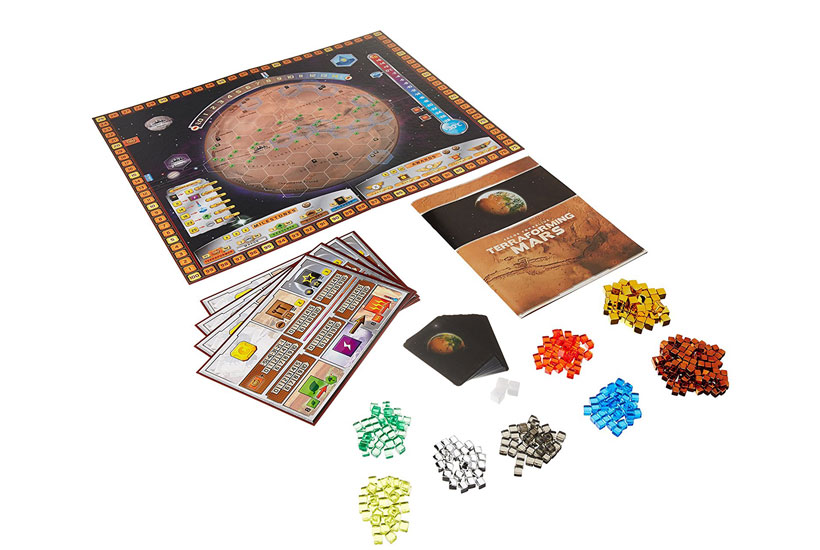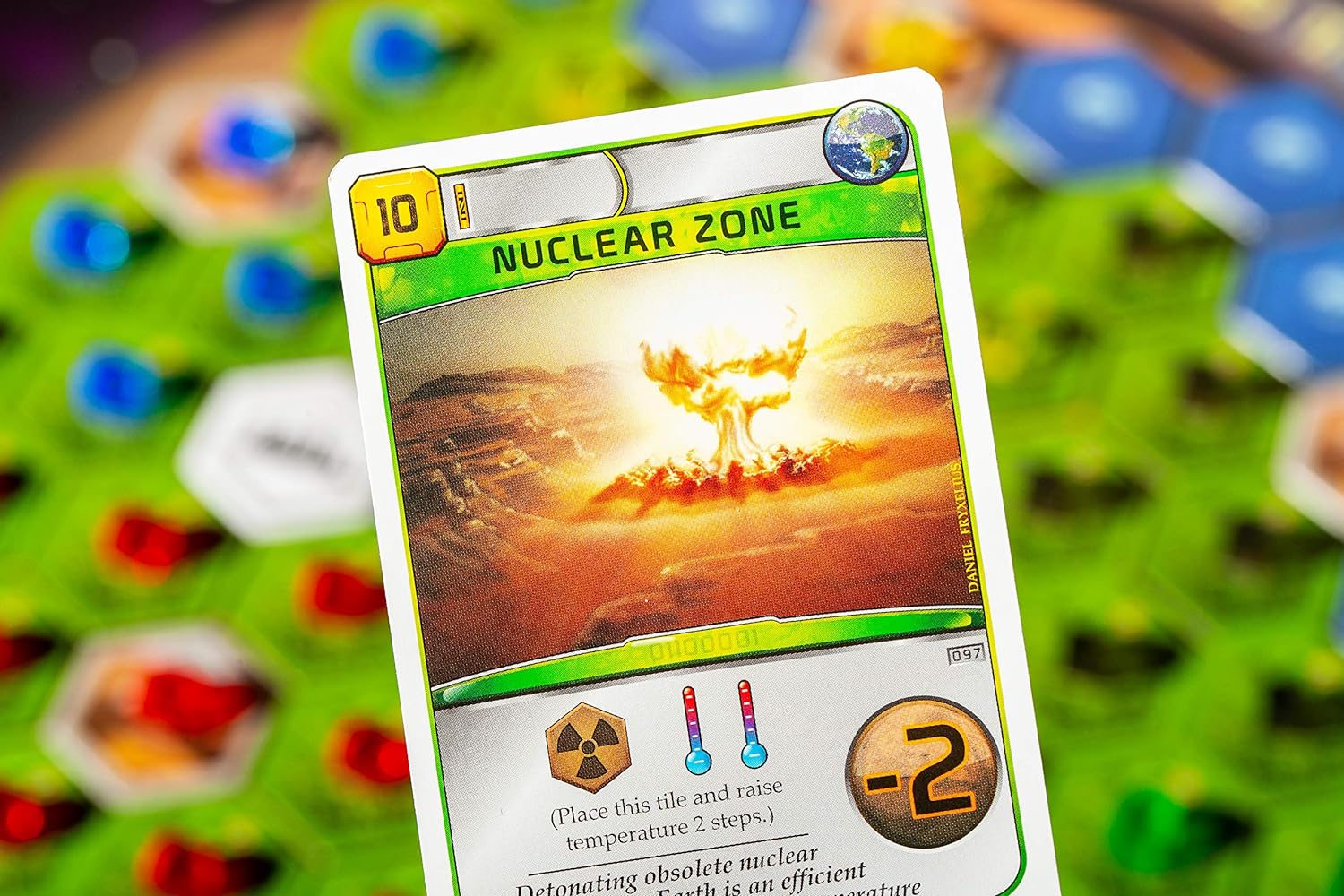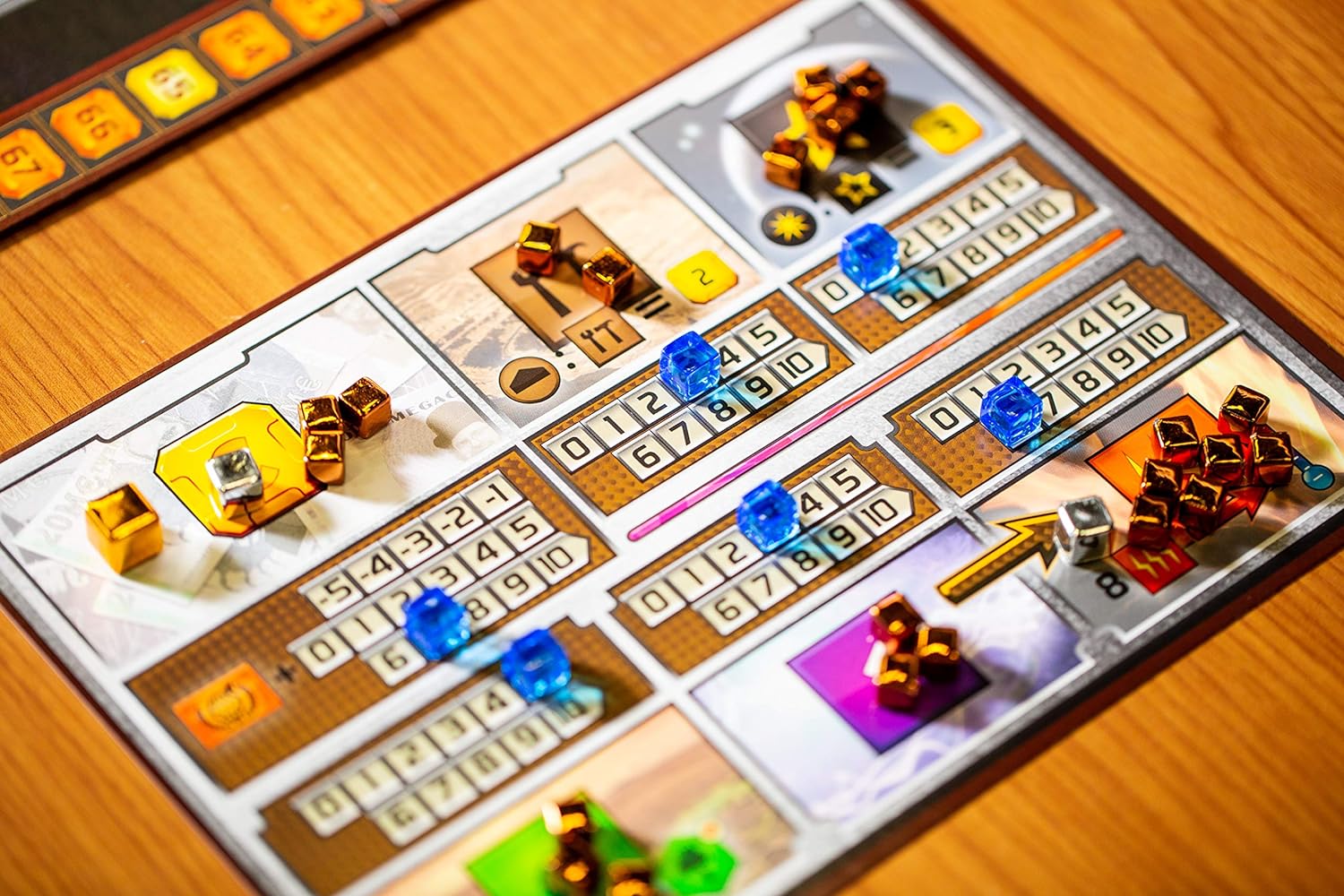Terraforming Mars is like playing Mother Nature’s favorite video game. It’s the saga of Earth’s greatest gardeners turning the rusty, barren wasteland of Mars into a swanky interstellar resort.
Picture this: You’re a tech-savvy, green-thumbed genius with a grand vision – to transform Mars into the hippest vacation spot in the galaxy. How? By throwing greenhouses all over the place, launching meteors for fun and profit, and melting polar ice caps to create Martian beachfront property (don’t forget the sunscreen).
But it’s not all roses. You’ll have to fend off dust storms, manage your resources like a cosmic accountant, and deal with those pesky neighbors who want a piece of your Martian pie. And let’s not even talk about the red tape of bureaucracy – literally, red tape, since Mars is kind of dusty.
Oh, and there are these things called Victory Points. They’re like Martian street cred. The more you have, the cooler you are in the cosmic clubhouse.
So, gather your scientist friends, stock up on potatoes (just in case), and let the terraforming commence. It’s a game where you get to be Elon Musk without the stress, all while turning Mars into a thriving, green utopia.
Just remember, the next time you look at the night sky, you can say: “I played a part in making Mars great again.”
What’s included in Terraforming Mars

- Game board representing Mars
- Corporation cards (prelude and regular)
- Project cards
- Resource cubes (for MegaCredits, Steel, Titanium, Plants, Energy, and Heat)
- Player markers for terraforming rating, VPs, and generation marker
- Standard project cards
- Tiles for oceans, greenery, and cities
- Awards and milestones tiles
- Terraforming rating tiles
- First player token
- 9 Ocean tiles, 60 Greenery/City tiles, and 11 Special tiles
- Action cards
- Rules booklet
How to play Terraforming Mars?

Setup
- Place the game board in the center of the table.
- Separate the Ocean tiles, Greenery/City tiles, and Special tiles and place them nearby.
- Shuffle the Project cards into three decks: Era I, Era II, and Era III. Place these decks on their respective slots on the game board.
- Shuffle the Prelude cards and deal four to each player, allowing them to choose two to keep and return the others.
- Each player chooses a corporation card from the available options.
- Players receive MegaCredits (MC) according to their corporation cards.
- Place resource cubes (Steel, Titanium, Plants, Energy, and Heat) in their respective supply areas.
- Set up the Terraforming Rating (TR) tiles and place each player’s marker on the “20” space.
- Place the First Player token with the starting player.
Rules for Terraforming Mars

Terraforming Mars is played in generations, consisting of the following phases:
- Research Phase: Players receive income in the form of MegaCredits, resources, and cards based on their corporation cards and any Prelude cards they played.
- Action Phase: Players take turns performing actions in clockwise order. Actions may include playing project cards, using standard projects, or passing (once a player passes, they don’t take further actions that generation).
- Production Phase: Players gain resources (Steel, Titanium, Plants, Energy, and Heat) from their terraformed tiles and cards.
- Heating Phase: Players may spend Heat to raise the temperature on the Terraforming Rating track.
- Greeneries Phase: Players may spend Plants to place Greenery tiles on the board.
- Ocean Phase: Players may spend resources to place Ocean tiles on the board.
- End-of-Generation Phase: Check for milestones, awards, and bonuses based on player achievements during the generation.
- Adjust Generation Marker: Pass the First Player token clockwise and move the generation marker up by one.
Game End and Scoring: The game ends when players collectively achieve specific terraforming goals, such as maxing out the Terraforming Rating or placing all Ocean tiles. After the final generation, players calculate their VPs based on various factors, including terraforming rating, project cards, milestones, and awards. The player with the most VPs wins.
For the official rules, see the link below:
Winning Strategies for Terraforming Mars
Winning Terraforming Mars can be challenging due to the game’s complexity and the variety of strategies available. Success often requires careful planning, adaptability, and efficient resource management. Here are some tips to increase your chances of winning:
- Choose the Right Corporation: Your choice of corporation at the beginning of the game can greatly influence your strategy. Consider how your corporation’s special abilities and starting resources align with your long-term goals.
- Diversify Your Strategy: Don’t rely on a single approach. Diversify your actions and investments to maximize your income, terraforming rating, and card synergy. Balance investments in energy production, resource production, and terraforming projects.
- Focus on Early Income: Establish a strong economy early in the game. Generate MegaCredits and resources efficiently through production, energy, and titanium and steel production. Income is crucial for funding projects and terraforming efforts.
- Manage Resources Wisely: Resource management is key. Ensure you have a steady supply of essential resources like energy and heat. Use your actions and card abilities strategically to gain and convert resources as needed.
- Prioritize Terraforming Rating: Increasing your terraforming rating should be a priority. It unlocks new abilities and contributes to your final score. Focus on actions that raise temperature, place oceans, and increase greenery.
- Consider Card Synergy: Pay attention to the synergy between your corporation’s abilities, project cards, and available actions. Combining card effects can create powerful combos. Look for cards that complement your strategy.
- Claim Milestones and Awards: Aim to claim milestones and awards that match your progress. These provide significant Victory Points and can help you maintain a lead. Watch your opponents’ progress and adjust your strategy accordingly.
- Pay Attention to Opponents: Keep an eye on your opponents’ strategies. If someone is pursuing a similar approach, consider competing for resources or milestones more aggressively.
- Adapt to the Game State: Be flexible and adapt your strategy based on the evolving game state. Respond to the current temperature, ocean, and greenery situation, as well as your opponents’ actions.
- Use Timing to Your Advantage: Timing is critical. Delay certain actions until they have a maximum impact. For example, it may be more beneficial to wait to place an ocean when it will trigger a temperature increase.
- Maximize Card Draw: Card draw is random, but some card effects allow you to draw more cards or select from a larger pool. Use these abilities to increase your chances of obtaining useful cards.
- Plan for the Endgame: Terraforming Mars can end suddenly when players collectively reach specific terraforming goals. Ensure you have a plan for the endgame, including a strategy for the final generations.
- Practice and Learn: Terraforming Mars rewards experience. Play the game regularly to gain a better understanding of card interactions, strategies, and efficient resource management.
Remember that Terraforming Mars is a competitive game, and success can vary from one session to the next. Enjoy the process of exploring different strategies and adapting to the challenges presented in each game.